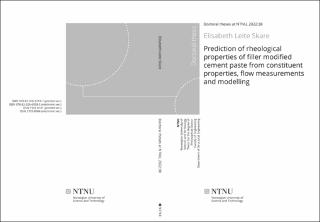| dc.contributor.advisor | Jacobsen, Stefan | |
| dc.contributor.advisor | Spangenberg, Jon | |
| dc.contributor.advisor | Mørtsell, Ernst Harald | |
| dc.contributor.advisor | Cepuritis, Rolands | |
| dc.contributor.author | Skare, Elisabeth Leite | |
| dc.date.accessioned | 2022-03-01T07:26:58Z | |
| dc.date.available | 2022-03-01T07:26:58Z | |
| dc.date.issued | 2022 | |
| dc.identifier.isbn | 978-82-326-6958-5 | |
| dc.identifier.issn | 2703-8084 | |
| dc.identifier.uri | https://hdl.handle.net/11250/2981905 | |
| dc.description.abstract | The world is facing a sand crisis due to depletion of natural deposits of good quality construction sand. Replacement of natural sand is crucial to curb the impact of the crisis. Though several alternatives exist, this thesis solely focus on crushed sand as replacement for natural sand. However, unless the crushed sand is properly processed, it is more angular and contains more fines than natural sand, which have a negative impact on concrete rheology. Measuring concrete rheology requires a lot of materials and labour, however, small scale rheology testing on equivalent cement pastes is found to correlate to concrete rheology. The thesis investigates the rheology of cement pastes with fillers from crushed sand, denoted matrices. The scope of the thesis is to investigate methods for quantification of matrix rheology, with emphasis on characteristics of the ingoing materials. Special focus is on the possibilities of establishing a one-point measurement of matrix rheology, i.e., a method describing the rheological behaviour of matrix by only one parameter. Limitations of and possibilities for further developing the flow viscometer FlowCyl are studied. Additionally, the accuracy and efficiency of artificial neural network predictions of the cement paste rheology are investigated and compared to semi-empirical suspension models. The rheological properties of the matrices have been quantified experimentally by four parameters; the flow resistance ratio (obtained from the FlowCyl), the mini slump flow, the Bingham yield stress and the Bingham plastic viscosity. From the work of the thesis it is found that it is possible to predict rheology of matrices based on constituent materials when all dry materials (except silica fume) are characterized by the volumetric specific surface area per volume of matrix, as well as their mix proportions. An empirical equation is developed, which correlates especially good to the plastic viscosity of the matrices. The main limitation of the FlowCyl is its weak correlation to yield stress, however, it is found that this correlation can be increased by changing the geometry of the FlowCyl. Based on numerical simulations a prototype of a modified geometry of the FlowCyl has been produced, called the FlowFunnel, which provides better correlations to the yield stress than the FlowCyl. Lastly, artificial neural network predictions are found to be an efficient and accurate prediction tool for matrix rheology. | en_US |
| dc.language.iso | eng | en_US |
| dc.publisher | NTNU | en_US |
| dc.relation.ispartofseries | Doctoral theses at NTNU;2022:38 | |
| dc.relation.haspart | Paper 1:
Skare, Elisabeth Leite; Cepuritis, Rolands; Spangenberg, Jon; Ramenskiy, Evgeny; Mørtsell, Ernst; Smeplass, Sverre; Jacobsen, Stefan.
Microproportioning paste with crushed aggregate filler by use of specific surface area. 15th International Congress on the Chemistry of Cement (ICCC 2019) | |
| dc.relation.haspart | Paper 2:
Skare, Elisabeth Leite; Cepuritis, Rolands; Mørtsell, Ernst; Smeplass, S.; Spangenberg, Jon; Jacobsen, Stefan.
Application of a New Empirical Model for Rheology Prediction of Cement Pastes Modified with Filler from Manufactured Sand. Nordic Concrete Research 2021 ;Volum 65.(2) https://doi.org/10.2478/ncr-2021-0005 This work is licensed under the Creative Commons Attribution-NonCommercial-NoDerivatives 3.0 License. (CC BY-NC-ND 4.0) | |
| dc.relation.haspart | Paper 3:
Skare, Elisabeth Leite; Sheiati, Shohreh; Cepuritis, Rolands; Mørtsell, Ernst; Smeplass, Sverre; Spangenberg, Jon; Jacobsen, Stefan.
Rheology Modelling of Cement Paste with Manufactured Sand and Silica Fume: Comparing Suspension Models with Artificial Neural Network Predictions. Construction and Building Materials 2022 ;Volum 317
https://doi.org/10.1016/j.conbuildmat.2021.126114
This is an open access article under the CC BY license | |
| dc.relation.haspart | Paper 4:
Cepuritis, Rolands; Jacobsen, Stefan; Skare, Elisabeth Leite; Spangenberg, Jon; Smeplass, Sverre; Mørtsell, Ernst.
FlowCyl: one-parameter cement paste rheology test developed at NTNU, Norway. Rhéologie 2019 ;Volum 35. s. 20-24 | |
| dc.relation.haspart | Paper 5:
Cepuritis, Rolands; Skare, Elisabeth Leite; Ramenskiy, Evgeny; Mørtsell, Ernst; Smeplass, Sverre; Li, Shizhao; Jacobsen, Stefan; Spangenberg, Jon.
Analysing limitations of the FlowCyl as a one-point viscometer test for cement paste. Construction and Building Materials 2019 ;Volum 218. s. 333-340
https://doi.org/10.1016/j.conbuildmat.2019.05.127 | |
| dc.relation.haspart | Paper 6:
Sheirati, Shoreh; Ranjbar, Navid; Frellsen, Jes; Skare, Elisabeth Leite; Cepuritis, Rolands; Jacobsen, Stefan; Spangenberg, Jon.
Neural network predictions of the simulated rheological response of cement paste in the FlowCyl. Neural computing & applications (Print) 2021 ;Volum 33. s. 13027-13037
https://doi.org/10.1007/s00521-021-05999-4 | |
| dc.relation.haspart | Paper 7:
Skare, Elisabeth Leite; Jacobsen, Stefan; Cepuritis, Rolands; Smeplass, Sverre; Spangenberg, Jon.
Decreasing the Magnitude of Shear Rates in the FlowCyl. I: 'Better, smarter, stronger'.
Reproduced from the proceedings of the International Federation for Structural Concrete 5th International fib Congress in Melbourne, Australia (2018). Better, smarter, stronger, page 3672 - “ paper "Decreasing the Magnitude of Shear Rates in the FlowCyl" with permission from the International Federation for Structural Concrete (fib). | |
| dc.relation.haspart | Paper 8:
Skare EL, Jacobsen S, Spangenberg J.
Investigating the flow curve of the FlowCyl test as a measure of yield stress. | |
| dc.relation.haspart | Paper 9:
Skare EL, Jacobsen S, Spangenberg J.
FlowFunnel for measuring yield stress and plastic viscosity of cement paste. | |
| dc.title | Prediction of rheological properties of filler modified cement paste from constituent properties, flow measurements and modelling | en_US |
| dc.type | Doctoral thesis | en_US |
| dc.subject.nsi | VDP::Technology: 500::Building technology: 530::Construction technology: 533 | en_US |
| dc.description.localcode | Digital fulltext is not available | en_US |

